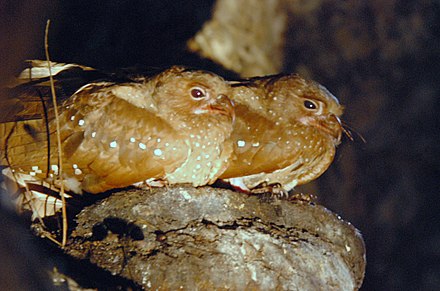Vanescaves
| Vanescaves | |
|---|---|

| |
| Oilbird, Steatornis caripensis | |
.jpg/440px-Apus_apus_-Barcelona,_Spain-8_(1).jpg)
| |
| Common swift, Apus apus | |
| Scientific classification | |
| Domain: | Eukaryota |
| Kingdom: | Animalia |
| Phylum: | Chordata |
| Class: | Aves |
| Clade: | Strisores |
| Clade: | Vanescaves Chen et al., 2019 |
| Subtaxa | |
| |
Vanescaves is a probable clade of strisorean birds that include the clades Steatornithiformes (the oilbird), Nyctibiiformes (the potoos), Podargiformes (frogmouths), and Apodimorphae (owlet-nightjars, swifts, and hummingbirds). Some molecular studies do support the grouping of these birds,[1][2][3] others offer conflicting positions of the non-apodimorphaean strisoreans.[4][5][6] In 2019 the authors Chen et al. performed a combined analysis using 2289 ultra-conserved elements [UCEs], 117 morphological characters from extant and fossil taxa found support in this clade.[7] The authors then proposed to name this group, which its meaning is Latin for "vanish birds" in reference to the disparate nature of their geographic distribution, as well as to the poem "A Route of Evanescence" by the American poet Emily Dickinson which features a hummingbird as the main subject.[7] In 2020 Chen & Field named the two major subclades of this group, with Sedentaves (oilbirds and potoos) and Letornithes (frogmouths, owlet-nightjars, swifts, and hummingbirds) for their crown-groups.[8]
Below is the overall phylogeny of Vanescaves as well as their sister group Caprimulgidae after Prum et al. (2015),[2] White & Braun (2019)[3] and Chen et al. (2019),[7] with phylocode names following Chen & Field (2020).[8]
| Strisores |
| ||||||||||||||||||||||||||||||||||||||||||
References
- ^ Ericson, Per G.P.; Anderson, Cajsa L.; Britton, Tom; Elżanowski, Andrzej; Johansson, Ulf S.; Källersjö, Mari; Ohlson, Jan I.; Parsons, Thomas J.; Zuccon, Dario; Mayr, Gerald (2006). "Diversification of Neoaves: integration of molecular sequence data and fossils" (PDF). Biology Letters. 2 (4): 543–547. doi:10.1098/rsbl.2006.0523. PMC 1834003. PMID 17148284. Archived from the original (PDF) on 2008-03-07.
- ^ a b Prum, Richard O.; Berv, Jacob S.; Dornberg, Alex; Field, Daniel J.; Townsend, Jeffrey P.; Lemmon, Emily Moriarty; Lemmon, Alan R. (2015). "A comprehensive phylogeny of birds (Aves) using targeted next-generation DNA sequencing". Nature. 526 (7574): 569–573. Bibcode:2015Natur.526..569P. doi:10.1038/nature15697. PMID 26444237. S2CID 205246158.
- ^ a b White, Noor D.; Braun, Michael J. (December 2019). "Extracting phylogenetic signal from phylogenomic data: Higher-level relationships of the nightbirds (Strisores)". Molecular Phylogenetics and Evolution. 141: 106611. doi:10.1016/j.ympev.2019.106611. PMID 31520780. S2CID 202573449.
- ^ Mayr, Gerald (2002). "Osteological evidence for paraphyly of the avian order Caprimulgiformes (nightjars and allies)". Journal für Ornithologie. 143 (1): 82–97. Bibcode:2002JOrni.143...82M. doi:10.1007/bf02465461. S2CID 42119957.
- ^ Mayr, Gerald (2010). "Phylogenetic relationships of the paraphyletic ,caprimulgiform' birds (nightjars and allies)". Journal of Zoological Systematics and Evolutionary Research. 48 (2): 857–879. doi:10.1111/j.1439-0469.2009.00552.x.
- ^ Reddy, Sushma; et al. (2015). "Why do phylogenomic data sets yield conflicting trees? Data type influences the avian tree of life more than taxon sampling". Systematic Biology. 66 (5): 857–879. doi:10.1093/sysbio/syx041. PMID 28369655.
- ^ a b c Chen, Albert; White, Noor D.; Benson, Roger B. J.; Braun, Michael J.; Field, Daniel J. (2019). "Total-evidence framework reveals complex morphological evolution in nightbirds (Strisores)". Diversity. 11 (9): 143. doi:10.3390/d11090143.
- ^ a b Chen, Albert; Field, Daniel J. (2020). "Phylogenetic definitions for Caprimulgimorphae (Aves) and major constituent clades under the International Code of Phylogenetic Nomenclature". Vertebrate Zoology. 70 (4): 571–585. doi:10.26049/VZ70-4-2020-03. eISSN 2625-8498. ISSN 1864-5755.